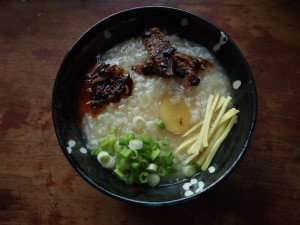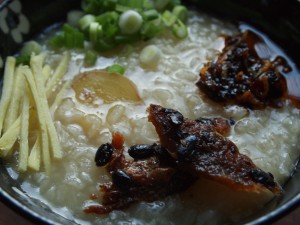
Congee is a Chinese breakfast dish – soothing, savoury, and aromatic with ginger and stock. (You may know it as choke, jook, bobo or cháo; it’s common all over Asia and its name varies as you’d expect with language and dialect.) I find it hard to separate the physiological effects of eating congee from the cultural ones. It’s a favourite dish when I’m ill, cold or miserable, but I couldn’t honestly tell you whether that’s because it makes me think of sharing a bowl in my pyjamas with my Dad; or because of the soothing magic that so many cultures assign to soupy, chickeny mixtures. It’s filling, easy to digest, and wonderfully satisfying. The Chinese say it’s good for an upset stomach, and it’s a standard sickbed dish used to perk up those with little appetite.
For Dad, it’s all about the texture. He’s even fond of plain congee, where water is used instead of stock. As a novice in congee, you’re likely to find the plain version too bland; my (English) mother and husband both say they would sooner eat papier-maché. At a conference in China earlier this year, I filled up happily every morning at the hotel buffet with a couple of small bowls of congee with century eggs, pickled bamboo shoots and catkins, while all my English colleagues looked on in horror over their Danish pastries. So I’ll happily admit that congee is not for everyone, though I can’t for the life of me work out why – you texture-phobes are eating more outlandish things every day. (Sausages, anybody?)
Congee is a base for you to add extra flavours to. There’s no ruleset to follow – top your porridge off with what you fancy. Here, I’ve used canned fried dace, a small oily fish, with black beans (available at all Chinese supermarkets). Try a dollop of Chinese chilli oil, some fresh ginger and spring onions, a splash of sesame oil. Experiment with your toppings, which are best when they’re salty and umami; I love Chinese pork floss (a kind of atomised jerky), Chinese wind-dried ham, century eggs or salted duck eggs, roasted meat, garlicky shitake mushrooms, and, for days when I’m feeling seriously brave, fermented tofu. Crispy dough crullers are a traditional addition, as are pickled mustard greens (zha cai), which you’ll find sold in vacuum-sealed plastic packs. This is a good time to explore the aisles of your local oriental supermarket; you’ll need to visit anyway to pick up the glutinous rice, so go mad and furtle in the darker corners of the shop to see if you can find any gingko nuts or dried scallops to accompany your porridge.

I like my congee relatively loose in texture. For a stiffer porridge, reduce the stock in the recipe by a couple of hundred millilitres. Some rice cookers have a congee setting – follow the instructions on yours if you’re lucky enough to have one. And as always, the stock you use should be as good as you can find; home-made is always best, and if it has a little fat floating on top, all the better.
For a congee base for 2-3 people, you’ll need:
150g glutinous rice
1.2 litres home-made chicken or pork stock
1-inch piece of ginger, cut into coins
1 teaspoon salt
Whatever you choose to top the congee with, you’ll find it much improved by:
Another 1-inch piece of ginger, peeled and cut into julienne strips
3-4 spring onions, cut into coins
2 teaspoons sesame oil
Soy sauce to taste
Rinse the rice in a sieve under the cold tap. Combine the stock and rice in a large saucepan with the salt and coins of ginger, and bring to the boil. Turn down to a bare simmer, and put the lid on. Continue to simmer for 1-1½ hours, until the congee has a creamy, porridgy texture. Stir the congee well. Spoon into bowls to serve, and sprinkle over the toppings.
I much prefer the flavour and texture you’ll get with glutinous rice, but if you really can’t find any, you can try the Cantonese style of congee, which is made with regular white rice and liquid in the same proportions as the recipe above, and boiled for about six hours until it breaks down into a mush. You’ll also find congee mixes including other grains, like barley and beans, for sale, particularly in the medicinal foods section.
